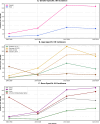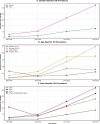This is a preprint.
Epidemiological Patterns, Treatment Response, and Metabolic Correlations of Idiopathic Intracranial Hypertension: A US-Based Study From 1990 to 2024
- PMID: 39711710
- PMCID: PMC11661347
- DOI: 10.1101/2024.12.08.24318685
Epidemiological Patterns, Treatment Response, and Metabolic Correlations of Idiopathic Intracranial Hypertension: A US-Based Study From 1990 to 2024
Update in
-
Epidemiological Patterns, Treatment Response, and Metabolic Correlations of Idiopathic Intracranial Hypertension: A United States-Based Study From 1990 to 2024.ASIDE Intern Med. 2025 Jan;1(1):31-39. doi: 10.71079/aside.im.0000012282413. Epub 2024 Dec 28. ASIDE Intern Med. 2025. PMID: 40697674 Free PMC article.
Abstract
Introduction: Idiopathic Intracranial Hypertension (IIH) presents an increasing health burden with changing demographic patterns. We studied nationwide trends in IIH epidemiology, treatment patterns, and associated outcomes using a large-scale database analysis within the United States (US).
Methods: We performed a retrospective analysis using the TriNetX US Collaborative Network database (1990-2024). We investigated demographic characteristics, time-based trends, geographic distribution, treatment pathways patterns, comorbidity profiles and associated risks with IIH. We used multivariate regression, Cox proportional hazards modeling, and standardized morbidity ratios to assess various outcomes and associations.
Results: Among 51,526 patients, we found a significant increase in adult IIH incidence from 16.0 to 127.0 per 100,000 (adjusted RR: 6.94, 95% CI: 6.71-7.17). Female predominance increased over time (female-to-male ratio: 3.29, 95% CI: 3.18-3.40). Southern regions showed the highest prevalence (43.0%, n=21,417). Initial medical management success rates varied between acetazolamide (42.3%) and topiramate (28.7%). Advanced interventional procedures showed 82.5% success rates in refractory cases. Cox modeling revealed significant associations between IIH and metabolic syndrome (HR: 2.14, 95% CI: 1.89-2.39) and cardiovascular complications (HR: 1.76, 95% CI: 1.58-1.94), independent of BMI.
Conclusions: Our findings highlight IIH as a systemic disorder with significant metabolic implications beyond its neurological manifestations. The marked regional disparities and rising incidence rates, especially among adults, suggest the need for targeted healthcare strategies. Early intervention success strongly predicts favorable outcomes, supporting prompt diagnosis and treatment initiation. These results advocate for an integrated approach combining traditional IIH management with broad metabolic screening care.
Keywords: Epidemiology; Headache; Idiopathic Intracranial Hypertension; Intracranial Pressure; Pesudotumor Cerebri.
Conflict of interest statement
Conflicts of Interest: N/A.
Figures




Similar articles
-
Epidemiological Patterns, Treatment Response, and Metabolic Correlations of Idiopathic Intracranial Hypertension: A United States-Based Study From 1990 to 2024.ASIDE Intern Med. 2025 Jan;1(1):31-39. doi: 10.71079/aside.im.0000012282413. Epub 2024 Dec 28. ASIDE Intern Med. 2025. PMID: 40697674 Free PMC article.
-
Interventions for idiopathic intracranial hypertension.Cochrane Database Syst Rev. 2015 Aug 7;2015(8):CD003434. doi: 10.1002/14651858.CD003434.pub3. Cochrane Database Syst Rev. 2015. PMID: 26250102 Free PMC article.
-
GLP-1 Receptor Agonists in Idiopathic Intracranial Hypertension.JAMA Neurol. 2025 Jul 14:e252020. doi: 10.1001/jamaneurol.2025.2020. Online ahead of print. JAMA Neurol. 2025. PMID: 40658395
-
A systematic review on idiopathic intracranial hypertension comorbid with polycystic ovarian syndrome and its consequences.Eur J Obstet Gynecol Reprod Biol. 2024 Jan;292:1-7. doi: 10.1016/j.ejogrb.2023.11.005. Epub 2023 Nov 7. Eur J Obstet Gynecol Reprod Biol. 2024. PMID: 37948928
-
A New Measure of Quantified Social Health Is Associated With Levels of Discomfort, Capability, and Mental and General Health Among Patients Seeking Musculoskeletal Specialty Care.Clin Orthop Relat Res. 2025 Apr 1;483(4):647-663. doi: 10.1097/CORR.0000000000003394. Epub 2025 Feb 5. Clin Orthop Relat Res. 2025. PMID: 39915110
References
-
- Ko M.W., et al. , Weight gain and recurrence in idiopathic intracranial hypertension: a case-control study. Neurology, 2011. 76(18): p. 1564–7. - PubMed
-
- Mollan S.P., et al. , New horizons for idiopathic intracranial hypertension: advances and challenges. Br Med Bull, 2020. 136(1): p. 118–126. - PubMed
-
- McCluskey G., et al. , Meta-analysis and systematic review of population-based epidemiological studies in idiopathic intracranial hypertension. Eur J Neurol, 2018. 25(10): p. 1218–1227. - PubMed
Publication types
Grants and funding
LinkOut - more resources
Full Text Sources
